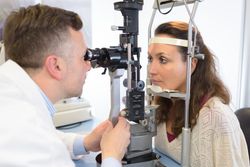Common Questions About Peripheral Vision

Peripheral vision is the ability to see objects to the side of your central focus when looking straight ahead. By scheduling annual exams, an eye doctor can spot irregularities and determine underlying causes of vision problems. Refer to the guide below on the importance of checking for signs of peripheral vision loss.
Peripheral Vision FAQ
What is peripheral vision loss?
If the periphery of the eye begins to deteriorate, this is regarded as peripheral vision loss. Eye diseases such as glaucoma, optic neuritis, and diabetic retinopathy can lead to deterioration. People can also experience vision loss in their periphery from an injury or trauma to the brain or eye, such as an optic stroke.
What are the signs of peripheral vision loss?
 Consult an eye doctor if you notice irregularities in vision or the appearance of your eyes. This can include prolonged swelling, redness, or soreness in one or both eyes, sensitivity to light, or problems seeing at night. Other indications are chronic headaches, vomiting, nausea, and seeing a shining halo or glare surrounding any sources of light.
Consult an eye doctor if you notice irregularities in vision or the appearance of your eyes. This can include prolonged swelling, redness, or soreness in one or both eyes, sensitivity to light, or problems seeing at night. Other indications are chronic headaches, vomiting, nausea, and seeing a shining halo or glare surrounding any sources of light.
How is it detected by an eye doctor?
Your eye doctor can ascertain the root cause and potential scope of damage through numerous exams such as a visual field test, a confrontation visual field test, or a Goldman field test. A visual field test asks patients to press a button whenever they see a flash of light in their periphery while staring at a dome-shaped device called a perimeter. The machine records the location of the flash when the button is pressed.
An alternate method is the confrontation visual field test in which a patient covers one eye while staring straight ahead across from the doctor. The patient will then notify the doctor whenever they see the doctor’s hand moving toward them.
The Goldman field test requires patients to sit across from a screen with a target in its center. The patient then indicates when they see something moving towards the center from their peripheral vision.
Is it treatable?
Depending on the cause, an eye doctor can potentially help reverse damage or slow progression. For instance, glaucoma can’t be cured, but impairment can be deterred through early intervention methods like using eye drops or medications and undergoing surgery. However, treatments may not completely reinstate lost vision. Further, your doctor may suggest changes in your exercise routine or diet, as well as consulting a specialist to examine any health conditions that could be affecting your vision.
When you need to consult a reputable optometrist about vision issues, turn to Blue Earth Valley Eye Clinic Ltd. in Blue Earth, MN. Offering a range of services from annual eye exams and glaucoma testing to contact lenses and glasses, they work with patients of all ages so that the entire family can be seen. They also have a second location in Winnebago for added convenience. Call the clinic at (507) 526-2222 or visit their website to schedule an appointment.
About the Business
Have a question? Ask the experts!
Send your question

